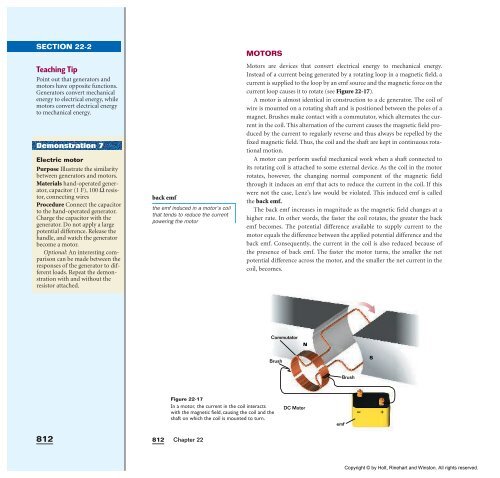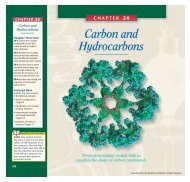Induction and Alternating Current with teacher's notes
Induction and Alternating Current with teacher's notes
Induction and Alternating Current with teacher's notes
Create successful ePaper yourself
Turn your PDF publications into a flip-book with our unique Google optimized e-Paper software.
SECTION 22-2<br />
Teaching Tip<br />
Point out that generators <strong>and</strong><br />
motors have opposite functions.<br />
Generators convert mechanical<br />
energy to electrical energy, while<br />
motors convert electrical energy<br />
to mechanical energy.<br />
Demonstration 7<br />
Electric motor<br />
Purpose Illustrate the similarity<br />
between generators <strong>and</strong> motors.<br />
Materials h<strong>and</strong>-operated generator,<br />
capacitor (1 F), 100 Ω resistor,<br />
connecting wires<br />
Procedure Connect the capacitor<br />
to the h<strong>and</strong>-operated generator.<br />
Charge the capacitor <strong>with</strong> the<br />
generator. Do not apply a large<br />
potential difference. Release the<br />
h<strong>and</strong>le, <strong>and</strong> watch the generator<br />
become a motor.<br />
Optional: An interesting comparison<br />
can be made between the<br />
responses of the generator to different<br />
loads. Repeat the demonstration<br />
<strong>with</strong> <strong>and</strong> <strong>with</strong>out the<br />
resistor attached.<br />
812<br />
back emf<br />
the emf induced in a motor’s coil<br />
that tends to reduce the current<br />
powering the motor<br />
812<br />
Chapter 22<br />
MOTORS<br />
Figure 22-17<br />
In a motor, the current in the coil interacts<br />
<strong>with</strong> the magnetic field, causing the coil <strong>and</strong> the<br />
shaft on which the coil is mounted to turn.<br />
Motors are devices that convert electrical energy to mechanical energy.<br />
Instead of a current being generated by a rotating loop in a magnetic field, a<br />
current is supplied to the loop by an emf source <strong>and</strong> the magnetic force on the<br />
current loop causes it to rotate (see Figure 22-17).<br />
A motor is almost identical in construction to a dc generator. The coil of<br />
wire is mounted on a rotating shaft <strong>and</strong> is positioned between the poles of a<br />
magnet. Brushes make contact <strong>with</strong> a commutator, which alternates the current<br />
in the coil. This alternation of the current causes the magnetic field produced<br />
by the current to regularly reverse <strong>and</strong> thus always be repelled by the<br />
fixed magnetic field. Thus, the coil <strong>and</strong> the shaft are kept in continuous rotational<br />
motion.<br />
A motor can perform useful mechanical work when a shaft connected to<br />
its rotating coil is attached to some external device. As the coil in the motor<br />
rotates, however, the changing normal component of the magnetic field<br />
through it induces an emf that acts to reduce the current in the coil. If this<br />
were not the case, Lenz’s law would be violated. This induced emf is called<br />
the back emf.<br />
The back emf increases in magnitude as the magnetic field changes at a<br />
higher rate. In other words, the faster the coil rotates, the greater the back<br />
emf becomes. The potential difference available to supply current to the<br />
motor equals the difference between the applied potential difference <strong>and</strong> the<br />
back emf. Consequently, the current in the coil is also reduced because of<br />
the presence of back emf. The faster the motor turns, the smaller the net<br />
potential difference across the motor, <strong>and</strong> the smaller the net current in the<br />
coil, becomes.<br />
Commutator<br />
Brush<br />
N<br />
DC Motor<br />
emf<br />
Brush<br />
S<br />
+<br />
Copyright © by Holt, Rinehart <strong>and</strong> Winston. All rights reserved.
















